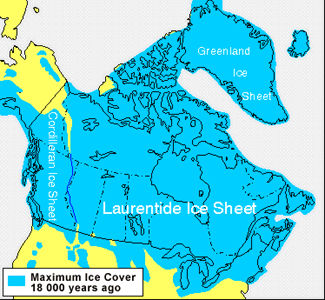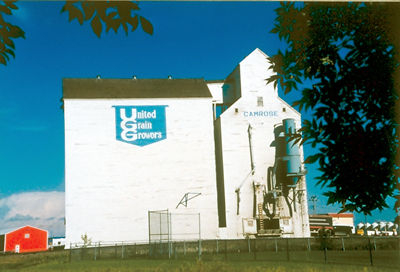Browse "Science & Technology"
-
Article
Geology
Earth is 70.8% covered by water, but only with the development of sonar techniques has it become possible to describe the solid earth below the oceans. With increasingly sophisticated satellite observations, relatively fine structural details (eg, areas of volcanic activity) can be seen.
"https://development.thecanadianencyclopedia.ca/images/tce_placeholder.jpg?v=e9dca980c9bdb3aa11e832e7ea94f5d9" // resources/views/front/categories/view.blade.php
https://development.thecanadianencyclopedia.ca/images/tce_placeholder.jpg?v=e9dca980c9bdb3aa11e832e7ea94f5d9
-
Article
Geomatics Canada
Geomatics Canada, along with the Geological Survey of Canada and the Polar Continental Shelf Project, became part of the Earth Sciences Sector of the Department of Natural Resources in the mid-1990s. It was formerly known as the Surveys, Mapping and Remote Sensing Sector.
"https://development.thecanadianencyclopedia.ca/images/tce_placeholder.jpg?v=e9dca980c9bdb3aa11e832e7ea94f5d9" // resources/views/front/categories/view.blade.php
https://development.thecanadianencyclopedia.ca/images/tce_placeholder.jpg?v=e9dca980c9bdb3aa11e832e7ea94f5d9
-
Article
Geomorphology
Geomorphology is related to GEOLOGY because of the importance of long timescales, tectonic deformation of Earth's crust (seePLATE TECTONICS), and rock and sediment properties; and to physical geography through its association with CLIMATE, BIOGEOGRAPHY, SOIL SCIENCE, and HYDROLOGY.
"https://d2ttikhf7xbzbs.cloudfront.net/media/media/c495f574-0f22-4771-8a0e-1775d86b2843.jpg" // resources/views/front/categories/view.blade.php
https://d2ttikhf7xbzbs.cloudfront.net/media/media/c495f574-0f22-4771-8a0e-1775d86b2843.jpg
-
Article
Geothermal Energy
Geothermal Energy is the exploitable heat within the Earth. The interior of the planet is maintained at a high temperature by a vast store of heat, of which part remains from the formation of the Earth and part is continually generated by the decay of radioactive elements
"https://development.thecanadianencyclopedia.ca/images/tce_placeholder.jpg?v=e9dca980c9bdb3aa11e832e7ea94f5d9" // resources/views/front/categories/view.blade.php
https://development.thecanadianencyclopedia.ca/images/tce_placeholder.jpg?v=e9dca980c9bdb3aa11e832e7ea94f5d9
-
Article
German Furniture
Furniture of Germanic derivation has come to Canada as a result of emigration from Germany and from Pennsylvania (see GERMANS). Traditional German furniture in Europe evolved over several centuries to serve the needs of ordinary, primarily rural, people.
"https://development.thecanadianencyclopedia.ca/images/tce_placeholder.jpg?v=e9dca980c9bdb3aa11e832e7ea94f5d9" // resources/views/front/categories/view.blade.php
https://development.thecanadianencyclopedia.ca/images/tce_placeholder.jpg?v=e9dca980c9bdb3aa11e832e7ea94f5d9
-
Article
Gerontology
Gerontology is the scientific study of AGING and its consequences including psychological, biological, and social changes confronting individuals, the social and economic issues created by growing numbers of older people in a population, and the opportunities older age brings with it.
"https://development.thecanadianencyclopedia.ca/images/tce_placeholder.jpg?v=e9dca980c9bdb3aa11e832e7ea94f5d9" // resources/views/front/categories/view.blade.php
https://development.thecanadianencyclopedia.ca/images/tce_placeholder.jpg?v=e9dca980c9bdb3aa11e832e7ea94f5d9
-
Article
Glaciation
Glaciation is the formation, movement and recession of glaciers. Glaciation was much more extensive in the past, when much of the world was covered in large, continental ice sheets. Currently, glaciers cover about 10 per cent of the world's land area (14.9 million km2).
"https://d2ttikhf7xbzbs.cloudfront.net/media/media/cc15de4d-3449-4ba6-8e56-feea6be2179c.jpg" // resources/views/front/categories/view.blade.php
https://d2ttikhf7xbzbs.cloudfront.net/media/media/cc15de4d-3449-4ba6-8e56-feea6be2179c.jpg
-
Article
Glass
The first known Canadian glass factory or glasshouse, the Mallorytown Glass Works in Upper Canada, began operation in 1839 and closed in 1840. Glassmaking involved a large investment in raw materials, equipment and salaries.
"https://development.thecanadianencyclopedia.ca/images/tce_placeholder.jpg?v=e9dca980c9bdb3aa11e832e7ea94f5d9" // resources/views/front/categories/view.blade.php
https://development.thecanadianencyclopedia.ca/images/tce_placeholder.jpg?v=e9dca980c9bdb3aa11e832e7ea94f5d9
-
Macleans
Global Warming Crisis
This article was originally published in Maclean’s magazine on February 21, 2000. Partner content is not updated. Across the Arctic, the ominous signs are everywhere. With average temperatures in some parts of the Canadian North rising at the rate of about 1° C each decade, glaciers are in retreat. Scientists report a dramatic thinning of the Polar ice cap.
"https://development.thecanadianencyclopedia.ca/images/tce_placeholder.jpg?v=e9dca980c9bdb3aa11e832e7ea94f5d9" // resources/views/front/categories/view.blade.php
https://development.thecanadianencyclopedia.ca/images/tce_placeholder.jpg?v=e9dca980c9bdb3aa11e832e7ea94f5d9
-
Article
Grain Elevators
Grain elevators, which have been variously referred to as prairie icons, prairie cathedrals or prairie sentinels, are a visual symbol of western Canada. Numbering as many as 5,758 in 1933, elevators have dominated the prairie landscape for more than a century with every hamlet, village and town boasting its row of them, a declaration of a community's economic viability and a region's agricultural strength.
"https://d2ttikhf7xbzbs.cloudfront.net/media/media/ca7c03ab-8e7b-40ff-b6f4-3eae507eb411.jpg" // resources/views/front/categories/view.blade.php
https://d2ttikhf7xbzbs.cloudfront.net/media/media/ca7c03ab-8e7b-40ff-b6f4-3eae507eb411.jpg
-
Article
Grain Growers' Associations
Grain growers' associations are a group of farm organizations formed on the Prairies in the early 20th century. They developed in the wake of the Manitoba Grain Act (July 1900), which regulated railways and grain elevators in the interests of grain growers.
"https://development.thecanadianencyclopedia.ca/images/tce_placeholder.jpg?v=e9dca980c9bdb3aa11e832e7ea94f5d9" // resources/views/front/categories/view.blade.php
https://development.thecanadianencyclopedia.ca/images/tce_placeholder.jpg?v=e9dca980c9bdb3aa11e832e7ea94f5d9
-
Article
Grain Growers' Guide
Grain Growers' Guide, journal published 1908-28 for Prairie grain growers' associations. In 1928 it became the Country Guide, which is still published by the United Grain Growers in Winnipeg. Editors included E.A. PARTRIDGE, Roderick McKenzie and (1911-35) George Chipman.
"https://development.thecanadianencyclopedia.ca/images/tce_placeholder.jpg?v=e9dca980c9bdb3aa11e832e7ea94f5d9" // resources/views/front/categories/view.blade.php
https://development.thecanadianencyclopedia.ca/images/tce_placeholder.jpg?v=e9dca980c9bdb3aa11e832e7ea94f5d9
-
Article
Grain Handling and Marketing
There are approximately 120 000 grain-producing farms in Canada. Yearly production varies substantially, depending on climatic conditions. Grain production has doubled since the 1950s, with wheat making up a large percentage of production. In 1997-98, total Canadian wheat exports were 15.
"https://development.thecanadianencyclopedia.ca/images/tce_placeholder.jpg?v=e9dca980c9bdb3aa11e832e7ea94f5d9" // resources/views/front/categories/view.blade.php
https://development.thecanadianencyclopedia.ca/images/tce_placeholder.jpg?v=e9dca980c9bdb3aa11e832e7ea94f5d9
-
Article
Gravity
Gravity, the fundamental physical property of attraction between all bodies, is here considered mainly as it relates to the study of the Earth.
"https://development.thecanadianencyclopedia.ca/images/tce_placeholder.jpg?v=e9dca980c9bdb3aa11e832e7ea94f5d9" // resources/views/front/categories/view.blade.php
https://development.thecanadianencyclopedia.ca/images/tce_placeholder.jpg?v=e9dca980c9bdb3aa11e832e7ea94f5d9
-
Macleans
Green Driving Machines
From the outside there was little to distinguish the sleek Toyota Prius from any other car on the streets of Timmins, Ont. But when the driver turned the key, it was clear this was no ordinary sedan. The only sound as the Prius pulled away was the gentle hum of an electric motor.This article was originally published in Maclean's Magazine on July 20, 1998
"https://development.thecanadianencyclopedia.ca/images/tce_placeholder.jpg?v=e9dca980c9bdb3aa11e832e7ea94f5d9" // resources/views/front/categories/view.blade.php
https://development.thecanadianencyclopedia.ca/images/tce_placeholder.jpg?v=e9dca980c9bdb3aa11e832e7ea94f5d9
